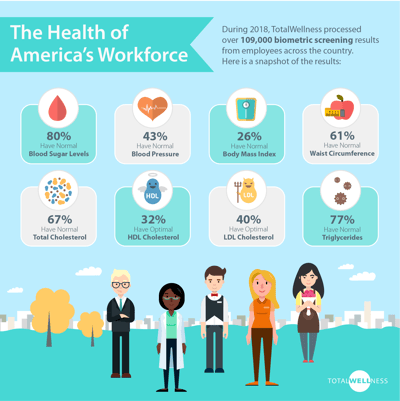 Each year, TotalWellness collects extensive data to better understand the health status of U.S. employees. In 2018 alone, we conducted over 100,000 biometric screenings across workplaces in the United States.
Each year, TotalWellness collects extensive data to better understand the health status of U.S. employees. In 2018 alone, we conducted over 100,000 biometric screenings across workplaces in the United States.
Our standard biometric screening consist of a variety of health measures including:
- Cholesterol
- Blood sugar
- Body Mass Index (BMI)
- Blood pressure
- Waist circumference
These screenings offer pertinent insight to the well-being and health of employees. Once the results are finalized, we share a report with each company’s wellness team to better support employees through wellness programming.
Now, we want to share the nationwide results with you.
What the Numbers Say About Employee Health
TotalWellness provides aggregate reports of each company’s biometric health screenings. This makes it easier to look at the big picture of employee health in one snapshot.
Here’s the results of our data collection from 2018:
Cholesterol
Cholesterol is a type of fat-like substance that’s found in the blood. It can come both from our bodies and from the food we eat.
What Our Research Found
Of our participants, 67% have normal total cholesterol. Total blood cholesterol is a measure of all the cholesterol components.
TC/HDL Ratio
- 50% have optimal TC/HDL Cholesterol
HDL Cholesterol (“Good” Cholesterol)
- 32% have optimal HDL Cholesterol
- 47% have near optimal HDL Cholesterol
- 21% had low (high risk) HDL Cholesterol
LDL Cholesterol (“Bad” Cholesterol)
- 40% have optimal LDL Cholesterol
- 18% have borderline high LDL Cholesterol
- 1% had very high LDL Cholesterol
According to the Cleveland Clinic, anyone over 20 years old should get cholesterol levels measured at least once every 5 years.
Glucose
Blood glucose is often used as an indicator of a person’s potential diabetes risk. These screenings are used to evaluate diabetes risk, but abnormal results can also indicate a variety of other health issues. Left untreated, high blood sugar can damage your eyes, kidneys, nerves, heart and blood vessels.
What Our Research Found
Of our participants, most have normal glucose levels.
- 80% participants have normal blood glucose
- 16% are prediabetic
- 4% have diabetes
Blood Pressure
Blood pressure refers to the pressure of blood against the inside walls of blood vessels. These blood vessels carry important nutrients, like oxygen, to all parts of our bodies. All of our tissues and organs need proper oxygenated blood. This pressure is responsible for pushing the nutrient-rich blood through veins, capillaries, and arteries. If blood pressure is too high or too low, it can cause harm by making the heart and blood vessels work overtime. This can lead to cardiovascular issues.
What Our Research Found
Of our participants, 43% have normal blood pressure.
- 14% had elevated blood pressure levels
- 32% Stage 1 hypertension
- 11% had Stage 2 hypertension
- 0% were in hypertensive crisis
Body Mass Index (BMI)
BMI is considered a reliable indicator of obesity. Health issues like diabetes or heart disease risk factors increase tremendously once BMIs rise above 21. A collection of research from Harvard’s School of Public Health reports adults who gained 22 pounds or more have a higher risk of developing chronic diseases.
What Our Research Found
Of our participants, only 26% have a normal body mass index.
- 33% of participants were overweight
- 21% had a high weight
- 11% had a very high weight
- 8% had an extremely high weight (40+ pounds)
Waist Circumference
Along with measuring BMI, waist circumference is another useful measure for checking obesity risk. When most of an employee’s fat is around the waist and not the hips, it increases the risk of type 2 diabetes and heart disease.
Why it Matters
As waistlines expand, so does the risk of health issues like being overweight or having obesity-related diseases. Larger waistlines mean an increase risk of high blood glucose, high triglycerides, physical inactivity, and high blood pressure.
What Our Research Found
Of our participants, 61% have a normal waistline circumference. 39% had a high waist circumference (men measuring at 41+ inches and women at 36+ inches).
From beginning to end, our team guides our clients through the process of biometric screenings. It’s a great way to encourage employees to take a hard look at their health, as well as help employers establish a stronger wellness culture.


